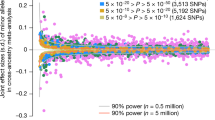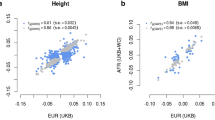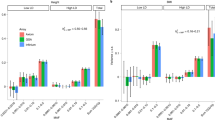Abstract
We estimate and partition genetic variation for height, body mass index (BMI), von Willebrand factor and QT interval (QTi) using 586,898 SNPs genotyped on 11,586 unrelated individuals. We estimate that ∼45%, ∼17%, ∼25% and ∼21% of the variance in height, BMI, von Willebrand factor and QTi, respectively, can be explained by all autosomal SNPs and a further ∼0.5–1% can be explained by X chromosome SNPs. We show that the variance explained by each chromosome is proportional to its length, and that SNPs in or near genes explain more variation than SNPs between genes. We propose a new approach to estimate variation due to cryptic relatedness and population stratification. Our results provide further evidence that a substantial proportion of heritability is captured by common SNPs, that height, BMI and QTi are highly polygenic traits, and that the additive variation explained by a part of the genome is approximately proportional to the total length of DNA contained within genes therein.
This is a preview of subscription content, access via your institution
Access options
Subscribe to this journal
Receive 12 print issues and online access
$209.00 per year
only $17.42 per issue
Buy this article
- Purchase on Springer Link
- Instant access to full article PDF
Prices may be subject to local taxes which are calculated during checkout




Similar content being viewed by others
References
Hindorff, L.A. et al. Potential etiologic and functional implications of genome-wide association loci for human diseases and traits. Proc. Natl. Acad. Sci. USA 106, 9362–9367 (2009).
Manolio, T.A. et al. Finding the missing heritability of complex diseases. Nature 461, 747–753 (2009).
Manolio, T.A. Genomewide association studies and assessment of the risk of disease. N. Engl. J. Med. 363, 166–176 (2010).
Yang, J. et al. Common SNPs explain a large proportion of the heritability for human height. Nat. Genet. 42, 565–569 (2010).
Visscher, P.M. et al. Genome partitioning of genetic variation for height from 11,214 sibling pairs. Am. J. Hum. Genet. 81, 1104–1110 (2007).
Rimm, E.B. et al. Prospective study of alcohol consumption and risk of coronary disease in men. Lancet 338, 464–468 (1991).
Colditz, G.A. & Hankinson, S.E. The Nurses' Health Study: lifestyle and health among women. Nat. Rev. Cancer 5, 388–396 (2005).
Psaty, B.M. et al. Cohorts for Heart and Aging Research in Genomic Epidemiology (CHARGE) consortium: design of prospective meta-analyses of genome-wide association studies from 5 cohorts. Circ. Cardiovasc. Genet. 2, 73–80 (2009).
Yang, J., Lee, S.H., Goddard, M.E. & Visscher, P.M. GCTA: a tool for genome-wide complex trait analysis. Am. J. Hum. Genet. 88, 76–82 (2011).
Visscher, P.M., Yang, J. & Goddard, M.E. A commentary on 'common SNPs explain a large proportion of the heritability for human height' by Yang et al. (2010). Twin Res. Hum. Genet. 13, 517–524 (2010).
Willer, C.J. et al. Six new loci associated with body mass index highlight a neuronal influence on body weight regulation. Nat. Genet. 41, 25–34 (2009).
Thorleifsson, G. et al. Genome-wide association yields new sequence variants at seven loci that associate with measures of obesity. Nat. Genet. 41, 18–24 (2009).
Frayling, T.M. et al. A common variant in the FTO gene is associated with body mass index and predisposes to childhood and adult obesity. Science 316, 889–894 (2007).
Speliotes, E.K. et al. Association analyses of 249,796 individuals reveal 18 new loci associated with body mass index. Nat. Genet. 42, 937–948 (2010).
Smith, N.L. et al. Novel associations of multiple genetic loci with plasma levels of factor VII, factor VIII, and von Willebrand factor: the CHARGE (Cohorts for Heart and Aging Research in Genome Epidemiology) consortium. Circulation 121, 1382–1392 (2010).
Shah, S.H. & Pitt, G.S. Genetics of cardiac repolarization. Nat. Genet. 41, 388–389 (2009).
Preston, A.E. & Barr, A. The plasma concentration of factor viii in the normal population. II. The effects of age, sex and blood group. Br. J. Haematol. 10, 238–245 (1964).
O'Donnell, J., Boulton, F.E., Manning, R.A. & Laffan, M.A. Amount of H antigen expressed on circulating von Willebrand factor is modified by ABO blood group genotype and is a major determinant of plasma von Willebrand factor antigen levels. Arterioscler. Thromb. Vasc. Biol. 22, 335–341 (2002).
Liu, J.Z. et al. A versatile gene-based test for genome-wide association studies. Am. J. Hum. Genet. 87, 139–145 (2010).
Price, A.L. et al. Principal components analysis corrects for stratification in genome-wide association studies. Nat. Genet. 38, 904–909 (2006).
Price, A.L., Zaitlen, N.A., Reich, D. & Patterson, N. New approaches to population stratification in genome-wide association studies. Nat. Rev. Genet. 11, 459–463 (2010).
Bulmer, M.G. The Mathematical Theory of Quantitative Genetics (Oxford University Press, New York, New York, USA, 1985).
Lango Allen, H. et al. Hundreds of variants clustered in genomic loci and biological pathways affect human height. Nature 467, 832–838 (2010).
Purcell, S.M. et al. Common polygenic variation contributes to risk of schizophrenia and bipolar disorder. Nature 460, 748–752 (2009).
Magnusson, P.K. & Rasmussen, F. Familial resemblance of body mass index and familial risk of high and low body mass index. A study of young men in Sweden. Int. J. Obes. Relat. Metab. Disord. 26, 1225–1231 (2002).
Schousboe, K. et al. Sex differences in heritability of BMI: a comparative study of results from twin studies in eight countries. Twin Res. 6, 409–421 (2003).
Eyre-Walker, A. Genetic architecture of a complex trait and its implications for fitness and genome-wide association studies. Proc. Natl. Acad. Sci. USA 107, 1752–1756 (2010).
The 1000 Genomes Project Consortium. A map of human genome variation from population-scale sequencing. Nature 467, 1061–1073 (2010).
Dickson, S.P., Wang, K., Krantz, I., Hakonarson, H. & Goldstein, D.B. Rare variants create synthetic genome-wide associations. PLoS Biol. 8, e1000294 (2010).
McClellan, J. & King, M.-C. Genetic heterogeneity in human disease. Cell 141, 210–217 (2010).
Teslovich, T.M. et al. Biological, clinical and population relevance of 95 loci for blood lipids. Nature 466, 707–713 (2010).
Visscher, P.M., Hill, W.G. & Wray, N.R. Heritability in the genomics era-concepts and misconceptions. Nat. Rev. Genet. 9, 255–266 (2008).
Orstavik, K.H. et al. Factor VIII and factor IX in a twin population. Evidence for a major effect of ABO locus on factor VIII level. Am. J. Hum. Genet. 37, 89–101 (1985).
de Lange, M., Snieder, H., Ariens, R.A., Spector, T.D. & Grant, P.J. The genetics of haemostasis: a twin study. Lancet 357, 101–105 (2001).
Dalageorgou, C. et al. Heritability of QT interval: how much is explained by genes for resting heart rate? J. Cardiovasc. Electrophysiol. 19, 386–391 (2008).
Russell, M.W., Law, I., Sholinsky, P. & Fabsitz, R.R. Heritability of ECG measurements in adult male twins. J. Electrocardiol. 30 Suppl, 64–68 (1998).
Qi, L. et al. Genetic variants at 2q24 are associated with susceptibility to type 2 diabetes. Hum. Mol. Genet. 19, 2706–2715 (2010).
Cornelis, M.C. et al. The gene, environment association studies consortium (GENEVA): maximizing the knowledge obtained from GWAS by collaboration across studies of multiple conditions. Genet. Epidemiol. 34, 364–372 (2010).
Laurie, C.C. et al. Quality control and quality assurance in genotypic data for genome-wide association studies. Genet. Epidemiol. 34, 591–602 (2010).
Purcell, S. et al. PLINK: a tool set for whole-genome association and population-based linkage analyses. Am. J. Hum. Genet. 81, 559–575 (2007).
Kent, J.W. Jr. Dyer, T.D. & Blangero, J. Estimating the additive genetic effect of the X chromosome. Genet. Epidemiol. 29, 377–388 (2005).
Zhang, Z. et al. Mixed linear model approach adapted for genome-wide association studies. Nat. Genet. 42, 355–360 (2010).
Kang, H.M. et al. Variance component model to account for sample structure in genome-wide association studies. Nat. Genet. 42, 348–354 (2010).
Acknowledgements
Funding support for the Gene, Environment Association Studies (GENEVA) project has been provided through the US National Institutes of Health Genes, Environment and Health Initiative. For the ARIC project, support was from U01 HG 004402 (PI: E.A. Boerwinkle). For the NHS and HPFS support is from U01 HG 004399 and U01 HG 004728 (PIs: F.B. Hu and L.R. Pasquale). The genotyping for the ARIC, NHS and HPFS studies was performed at the Broad Institute of MIT and Harvard with funding support from U01 HG04424 (PI: S. Gabriel). The GENEVA Coordinating Center receives support from U01 HG 004446 (PI: B.S. Weir). Assistance with GENEVA data cleaning was provided by the National Center for Biotechnology Information. D. Crosslin and C. Laurie of the GENEVA project assisted in making the data available for analysis. A Physician Scientist Award from Research to Prevent Blindness in New York City also supports L.R.P. M.C.C. is a recipient of a Canadian Institutes of Health Research Fellowship. We acknowledge funding from the Australian National Health and Medical Research Council (NHMRC grants 389892 and 613672) and the Australian Research Council (ARC grants DP0770096 and DP1093900). We thank D. Posthuma for discussions and the referees for constructive comments.
Author information
Authors and Affiliations
Contributions
P.M.V., M.E.G., B.S.W. and T.A.M. designed the study. J.Y. performed all statistical analyses. J.Y. and P.M.V. wrote the first draft of the paper. L.R.P., E.B., N.C., J.M.C., M.d.A., B.F., E.F., M.G.H., W.G.H., M.T.L., A.A., G.L., P.L., H.L., W.L., R.A.M., M.M., E.P. and M.C.C. contributed by providing genotype and phenotype data, by giving advice on analyses and interpretation of results and/or by giving advice on the contents of the paper.
Corresponding author
Ethics declarations
Competing interests
The authors declare no competing financial interests.
Supplementary information
Supplementary Text and Figures
Supplementary Figures 1–9, Supplementary Tables 1–13 and Supplementary Note. (PDF 1233 kb)
Rights and permissions
About this article
Cite this article
Yang, J., Manolio, T., Pasquale, L. et al. Genome partitioning of genetic variation for complex traits using common SNPs. Nat Genet 43, 519–525 (2011). https://doi.org/10.1038/ng.823
Received:
Accepted:
Published:
Issue Date:
DOI: https://doi.org/10.1038/ng.823
This article is cited by
-
Multivariate estimation of factor structures of complex traits using SNP-based genomic relationships
BMC Bioinformatics (2022)
-
DNA methylome-wide association study of genetic risk for depression implicates antigen processing and immune responses
Genome Medicine (2022)
-
A cognitive neurogenetic approach to uncovering the structure of executive functions
Nature Communications (2022)
-
Characterization of the genetic architecture of infant and early childhood body mass index
Nature Metabolism (2022)
-
Genic and non-genic SNP contributions to additive and dominance genetic effects in purebred and crossbred pig traits
Scientific Reports (2022)



